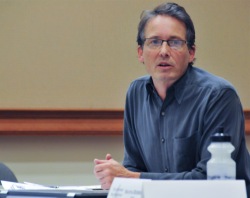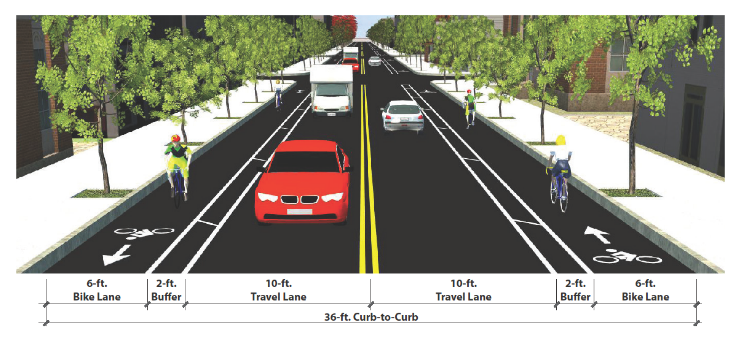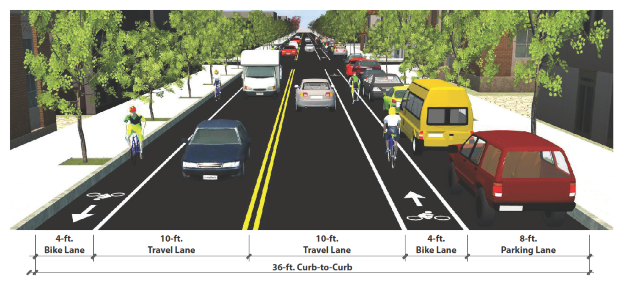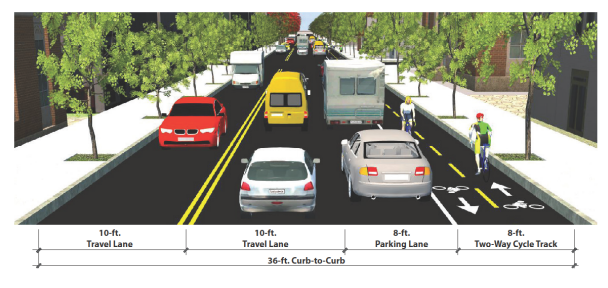
An “optimal” facility with buffered bike lanes in both directions, but no auto parking on 28th Avenue through its busiest commercial district, probably isn’t in the cards for the 20s Bikeway, a city project manager said this week.
The most comfortable biking plan “achievable,” city project manager Rich Newlands said in a presentation Tuesday to Portland’s Bicycle Advisory Committee, is a design that hasn’t been seen before in Portland or almost anywhere else: a shared lane in one direction, marked by green-backed sharrow stencils, with a buffered bike lane in the other direction.
“We’re going to run into this situation in many other sections of this bicycle network that run through these relatively constrained commercial districts.”
— Rich Newlands, 20s Bikeway project manager
Newlands referred to the plan as a “couplet,” since a nearby neighborhood street would also be improved into a neighborhood greenway that would let people avoid the shared lane by venturing out of direction a few blocks (similar to plans to create a neighborhood greenway on N Rodney as a low-stress alternate to N Williams Ave.)
The buffered lane would require parked cars to be removed from one side of 28th between Interstate 84 and Stark Street, Newlands said, probably the west side. By comparison, an “optimal” biking plan would require removing parking from both sides of the street, something Newlands said would probably be impossible due to anticipated resistance from businesses on 28th.
But at this point, the pushback is only assumed: Newlands said Tuesday night he hasn’t even begun direct outreach to adjacent businesses. (For a sense of what business owners on the strip think — it’s nuanced — you can read our coverage from December.)
Newlands said the compromise, whatever it is, is likely to become a “model” for bike facilities on the city’s other commercial streets.
“We’re going to run into this situation in many other sections of this bicycle network that run through these relatively constrained commercial districts,” he said. “If we get it wrong this is going to go down in flames.”
Newlands conceded that with 7,000 cars a day, 28th would “certainly warrant separation” between cars and bikes if there were room. For the many people uncomfortable biking in mixed traffic on 28th, he said, the city could create a “couplet” using 30th Avenue as a lower-stress northbound detour around the stretch in question:
But Newlands said he’s unsure whether people who want to improve 28th feel that this plan is “not just acceptable but worth supporting.”
“What I’m trying to gauge is whether people agree that this is a good type of facility,” Newlands said. “It does address many of the basic goals of this project. What I don’t know and what I’m not prepared to say here tonight is is it worth the tradeoff of that amount of on-street parking.”
If bike advocates don’t turn out to advocate strongly for this proposal, Newlands said, he’s “pretty certain” that “we will end up with the fallback that the corridor will bypass 28th and we’ll try to do as much as possible with traffic calming.”
The 20s Bikeway would be the first on-street bikeway to run the full length of the city from north to south. It’s part of the 2030 Bike Plan, which set a goal to make biking “more attractive than driving for trips of 3 miles or less.”
The neighborhood has a dense, walkable row of storefronts because, unlike the nearby parking-dominated commercial strip on Sandy, it wasn’t built with cars in mind. Its anchor buildings went up in the 1910s to serve riders of a streetcar line that then ran west on Ankeny and turned north on 28th. Unlike other streetcar routes such as Hawthorne and Burnside, 28th Avenue was never widened to make room for more cars — leading to today’s narrow range of options.
Newlands also presented renderings of three other options for the bikeway on 28th. First, the “optimal” bike facility with buffered bike lanes in both directions:
Then, a four-foot bike lane on both sides of the street:
Finally, a two-way bike lane on the west side, also only four feet wide and with no buffer between the lane and the right doors of parked cars:
Newlands also mentioned that it would be possible to remove one direction of auto traffic from the street in order to make room for comfortable biking in both directions.

Advisory Committee meeting last fall.
“I think it’s arguably a harder thing to pull off than getting rid of the on-street parking,” he said. “The two nearest collector streets that you could utilize are 20th and Cesar Chavez.” Another option would be to divert cars to a side street such as 30th, an option Newlands dismissed as politically impossible. “Imagine the conversation of having City Council take someone’s local street and turn it into a collector street,” he said.
Members of the Bicycle Advisory Committee seemed sympathetic to Newlands’ concerns but expressed little enthusiasm for the proposal. Committee Chairwoman Suzanne Veaudry Casaus said she stood ready to advocate for better biking through the area but wished she hadn’t seen a picture of the “optimal” facility before Newlands showed his rendering of the shared lane.
“For the willing but concerned,” a subset of riders Veaudry Casaus considers herself one of, “this was painful.”
Vice Chair Ian Stude suggested that the city consider moving the buffered bike lane to the east side of 28th, where most of the businesses sit, so their owners would be more likely to get the benefits of increased bike traffic past their storefronts.
“It gets us one step closer to an example of what we’re shooting for here,” Stude said. “It gets us to a better success story, or at least a photo op.”
More info on the 20s Bikeway Project:
– Past coverage on BikePortland
– PBOT’s official project page
Correction 2/20: An earlier version of this post overstated the traffic volume on 28th Avenue.






